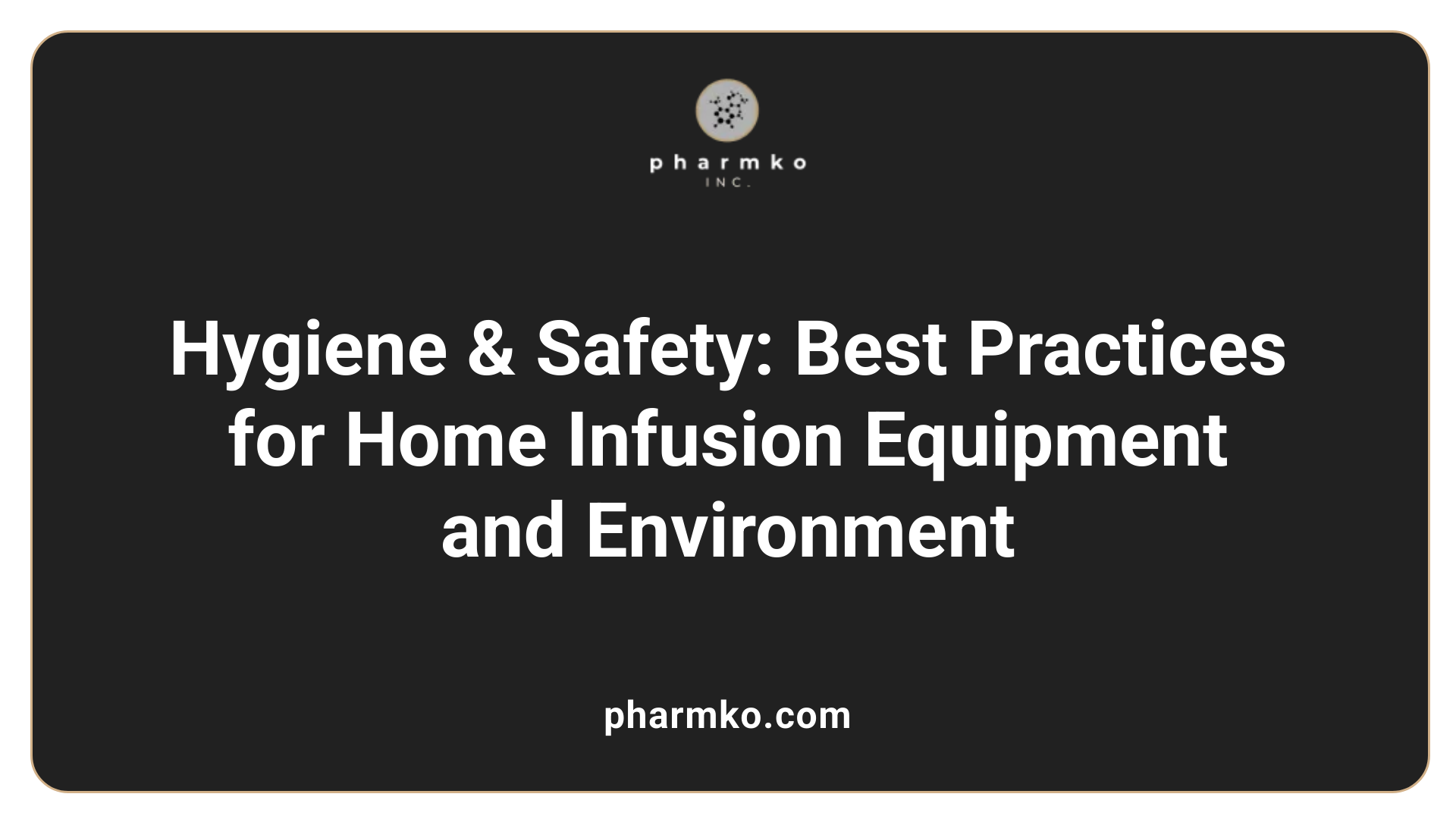Safe infusion techniques at home
Introduction to Home Infusion Techniques
Home infusion therapy is a vital healthcare service that enables patients to receive necessary intravenous treatments outside of traditional hospital settings. It encompasses a wide range of therapies such as antibiotics, chemotherapy, nutrition, and pain management, administered through various infusion devices. When performed correctly, home infusion offers benefits like increased comfort, convenience, and cost savings, provided proper safety protocols and training are followed.
Types of Infusions Administered at Home

What types of infusions can be administered at home?
Infusion therapy at home covers a broad spectrum of treatments that help manage various health conditions. Patients can receive medications through different routes depending on their specific needs, the medication's properties, and the length of therapy.
Among the most common infusions are antibiotics and antivirals, used to treat infections resistant to oral medications or requiring precise dosing and monitoring. Chemotherapy, which involves powerful drugs to combat cancer, can also be safely administered at home with proper equipment and supervision.
Nutritional therapies, including total parenteral nutrition (TPN), are vital for patients who cannot absorb nutrients through their gastrointestinal tract. These are delivered via specially placed catheters to ensure patients receive essential calories and nutrients.
Pain management and analgesia are other critical areas, especially for cancer care or chronic pain conditions. Patients often use patient-controlled analgesia (PCA) devices or continuous infusion methods for effective pain control.
Immune globulin therapies, enzyme replacements, and treatments for bleeding disorders are also suitable for home infusion. These therapies support immune function, replace deficient enzymes, or help manage blood clotting issues.
Finally, medications for heart failure and other chronic conditions can be infused at home, providing convenience and reducing hospital visits.
How are these infusions administered?
Most home infusion treatments involve delivering medication through IV lines via devices such as short peripheral IVs, which are suitable for short-term use, or long-term devices like peripherally inserted central catheters (PICCs) and implantable ports. These devices allow safe, consistent access to the bloodstream for the duration of therapy.
Insurance and safety considerations
Most modern healthcare plans, including Medicare and Medicaid, provide some coverage for home infusion services. However, the extent of coverage varies, so patients should verify their benefits. Proper training, equipment, and regular monitoring are vital to ensuring safety and effectiveness.
Supporting safe and effective home infusion
Coordinated care involving healthcare providers, trained nurses, pharmacists, and caregivers is essential. Patients and caregivers need thorough education on administering infusions, maintaining sterile techniques, recognizing adverse reactions, and properly managing equipment.
Home infusion therapy not only offers comfort and convenience but also supports high-quality treatment outside a hospital setting. With appropriate planning and professional support, patients can safely enjoy the benefits of receiving critical therapies at home while maintaining their quality of life.
Feasibility and Safety of Home Infusion Therapy

Is it safe and feasible to perform infusion therapy at home?
Performing infusion therapy at home is considered safe and practical when strict protocols and thorough preparations are in place. This type of therapy involves trained healthcare professionals, such as specialized nurses, who are skilled in administering medications via sterile techniques and using appropriate equipment, like infusion pumps and vascular access devices.
The process begins with comprehensive patient education and assessment, ensuring that both the patient and caregiver understand how to manage the infusion safely. Healthcare providers perform detailed home evaluations to confirm that the environment is suitable for infusion procedures, minimizing risks of infection and other complications.
Research consistently supports the safety of home infusion therapy. Studies indicate that, when properly managed, it has comparable safety outcomes to hospital care. Risks such as infections are reduced due to the focus on sterile techniques, and immediate recognition of adverse reactions is facilitated by the presence of trained staff. Additionally, home infusion allows for continuous monitoring and communication with healthcare teams through telehealth or regular check-ins.
The advantages extend beyond safety. Patients often experience greater comfort and satisfaction, appreciate the convenience of receiving treatment in familiar surroundings, and can maintain their daily routines. Conditions commonly managed with home infusion include complicated infections, autoimmune diseases, cancer treatments, and hydration needs.
Coordination among healthcare providers, including pharmacists, nurses, and physicians, is essential for optimal safety. This involves meticulous planning, device management, medication preparation, and vigilant monitoring for signs of adverse effects or device issues.
In summary, with adherence to established safety guidelines, proper staff training, patient education, and emergency preparedness, home infusion therapy provides a safe, effective, and patient-centered alternative to traditional hospital-based infusions.
Educating Patients and Caregivers in Safe Infusion Practices

How can patients and caregivers be educated on safe infusion practices?
Educating patients and their caregivers is a critical component of safe and effective home infusion therapy. To ensure safety and confidence, home care organizations should implement comprehensive training programs that are evidence-based and tailored to individual needs.
Training typically covers various aspects, including proper administration techniques, device handling, hygiene protocols, and recognizing complications. It begins with initial instruction that emphasizes understanding how to operate infusion pumps, change tubing, and manage infusion sites safely. Reinforcement is vital, so scheduled follow-up visits by trained nurses allow for assessment of skills, addressing questions, and troubleshooting any issues that arise.
Using multiple educational formats enhances understanding and retention. Written materials such as manuals or quick-reference guides provide accessible information. Visual aids and videos demonstrate correct techniques, and hands-on practice sessions allow patients and caregivers to become comfortable with the equipment.
Clear, standardized communication channels among the healthcare team ensure that everyone stays informed. Regular updates, prompt responses to questions, and detailed care plans support ongoing safety. Digital tools also play a significant role; apps, secure messaging systems, and online resource portals facilitate continuous learning and support.
By combining these strategies, healthcare providers can foster a safe environment for home infusion, empowering patients and caregivers to manage their therapy confidently while minimizing risks.
Procedures for Preparing and Managing Home Infusions

What procedures are involved in preparing and managing home infusion treatments?
Managing home infusion treatments involves a series of meticulous and detailed steps that ensure safety and effectiveness. The process begins with medication reconstitution and preparation. Medications requiring refrigeration, such as certain antibiotics or nutrients, must be brought to room temperature carefully—usually within 1 to 8 hours—avoiding microwaving, which can damage the drug. Checking expiration dates, inspecting medication labels, and confirming the integrity of the vials or bottles are critical steps.
Once prepared, the medication is transferred into infusion devices or bags. The choice of device—such as IV push syringes, elastomeric pumps, gravity infusion setups, or electronic ambulatory pumps—dictates specific procedures. Priming the tubing involves flushing the system with sterile fluid to remove air bubbles and ensure smooth flow. Proper connection of tubing and secure attachment to the infusion device precedes the actual administration.
During infusion management, monitoring for appropriate flow rates and device functionality is essential. This includes checking for kinks or obstructions in tubing, ensuring connections are tight, and observing the infusion site for adverse signs. Devices like pumps and elastomeric systems often have alarms—their correct setup and understanding how to respond are vital to prevent complications.
Troubleshooting alarms and technical issues is an ongoing task. Common alarms include occlusions, air in line, or power loss. Quickly interpreting alarm messages, inspecting the tubing, and clearing any blockages help maintain treatment efficacy. If problems persist, contacting healthcare providers for guidance ensures safety.
Maintaining strict sterile technique is a cornerstone of home infusion safety. Hands should be washed thoroughly before preparation or handling. Equipment and work surfaces must be sanitized with alcohol-based solutions, and all procedures should follow aseptic protocols consistent with USP <797> standards. Proper disposal of sharps and contaminated materials in designated containers minimizes infection risk.
Coordination with healthcare providers underpins successful therapy management. Regular communication enables adjustment of treatment plans, reporting of issues, and ongoing education for patients and caregivers. Patients are often instructed on how to recognize signs of infection or complication, and how to respond swiftly.
In summary, preparing and managing home infusion treatments encompass careful medication handling, precise device setup, vigilant monitoring, prompt troubleshooting, strict adherence to sterile practices, and seamless coordination with healthcare teams. These steps work together to ensure safe, effective, and patient-centered infusion care at home.
| Step | Action | Details |
|---|---|---|
| 1 | Medication Prep | Reconstitute, verify, and bring medication to room temperature |
| 2 | Filling Devices | Transfer medication into infusion containers or syringes |
| 3 | Priming Tubing | Flush tubing to eliminate air, ensure smooth flow |
| 4 | Setup Infusion | Connect tubing, secure all fittings, prepare for administration |
| 5 | Monitor Infusion | Check flow rate, device alarms, and site condition |
| 6 | Troubleshoot | Address alarms, check for blockages, contact provider if needed |
| 7 | Sterile Technique | Regular hand hygiene, sanitized work surface, proper disposal |
| 8 | Coordination | Communicate with healthcare team, report issues, get updates |
Best Practices and Protocols for Safe Home Infusion
What are the best practices and protocols for administering infusions at home?
Administering infusion therapy at home requires meticulous attention to safety, cleanliness, and proper technique. The process begins with comprehensive pre-infusion assessments, which involve evaluating the patient's health status, home environment, and caregiver support. Ensuring a clean, clutter-free space with adequate lighting and minimal disruptions is vital for safe procedures.
Proper preparation involves sterile compounding following USP <797> standards. This guarantees that medications are sterile, correctly labeled, and stored under appropriate conditions—some medications need refrigeration or freezing, and beyond-use dating must be strictly observed. Before each use, supplies and medications must be checked for leaks, tears, proper labels, and expiration dates.
Selecting the right infusion device depends on the medication's stability, the required dosing, and the therapy duration. Options range from IV push and elastomeric pumps to ambulatory and stationary infusion pumps. For example, ceftriaxone and cefazolin are typically administered via IV push, while vancomycin may be suited for elastomeric pumps.
Patient and caregiver education is fundamental. This includes training on infusion techniques, understanding alarm sounds, recognizing adverse reactions, and proper disposal of sharps and biomedical waste. Hands-on training and clear written instructions support confidence and safety.
Monitoring during infusion includes checking for proper device operation, signs of infection at the infusion site, and any adverse symptoms. Healthcare providers should be available for 24/7 support, and regular site assessments—such as daily inspection for redness, swelling, or drainage—help prevent infections.
In case alarms sound or complications arise, immediate actions involve checking tubing, inspecting for blockages or leaks, and following established protocols. Prompt communication with healthcare teams ensures timely intervention.
Documentation of the infusion process, including medication details, observations, and any issues, is necessary for ongoing care. Maintaining detailed records supports continuity, safety, and quality improvement.
Besides technical skills, rigorous infection control measures, including hand hygiene, sterile technique, and safe disposal practices, are essential. Patients and caregivers must be well-trained on these protocols to prevent infections.
Overall, integrating thorough assessments, proper device use, strict aseptic technique, diligent monitoring, effective communication, and ongoing education constitutes best practice for safe home infusion therapy, promoting positive outcomes and patient satisfaction.
Equipment, Hygiene, and Safety Considerations

What equipment, hygiene, and safety considerations should be taken into account during home infusion therapy?
Home infusion therapy demands meticulous attention to equipment, hygiene, and safety practices to prevent infections, ensure proper medication delivery, and protect both patients and caregivers. These practices include a series of steps and protocols that form the backbone of safe and effective infusion treatment at home.
Cleaning and disinfection of infusion equipment is crucial. All infusion pumps, tubing, connectors, and any reusable devices should be thoroughly cleaned and disinfected after each use. Following the manufacturer’s instructions and standard sterilization procedures helps eliminate pathogens that could cause infections. For single-use supplies, strict adherence to expiry dates and proper disposal after use is equally important.
Hand hygiene practices and infection prevention form the foundation of safe home infusion. Patients and caregivers must wash hands thoroughly with soap and water or use alcohol-based hand sanitizers before handling any infusion equipment, supplies, or medication. Proper hand hygiene prevents cross-contamination and reduces the risk of bloodstream infections.
Disposal of sharps and biohazardous waste must be performed carefully in designated sharps containers. These containers should be puncture-safe, leak-proof, and properly labeled. Follow local regulations for disposal; some areas have mail-back programs or designated disposal sites. Proper waste management not only safeguards the environment but also prevents injury.
Use of protective covers and sterile barriers helps maintain the sterility of infusion sites and access devices. When showering or performing daily activities, protective covers such as plastic drapes or waterproof covers for ports and catheters can prevent contamination. During medication preparation and infusion setup, sterile barriers and gloves reduce the risk of introducing bacteria.
Safety checks and device maintenance should be routine. Patients and caregivers are trained to perform daily inspections of devices for kinks, leaks, and correct alarm functioning. Regularly checking infusion sites for signs of infection, swelling, or redness, and ensuring the infusion pump is functioning properly, helps catch issues early before complications develop.
Patient and caregiver instructions on hygiene are vital. Clear guidance on handwashing techniques, cleaning protocols, safe needle handling, and environmental sanitation empower individuals to take responsibility for their safety. Continuous education about recognizing early signs of infection or device malfunction enhances proactive management.
Implementing these considerations ensures a high standard of safety, reduces risks of complications, and promotes successful home infusion therapy. Consistent training, adherence to protocols, and open communication among healthcare providers, patients, and caregivers are essential to maintain hygiene and safety throughout the treatment process.
| Aspect | Details | Best Practices |
|---|---|---|
| Equipment Cleaning & Disinfection | Use manufacturer guidelines; sterilize reusable items; replace single-use supplies | Sterilize after each use; check expiry dates |
| Hand Hygiene | Wash with soap and water or use sanitizer before handling equipment | Perform hand hygiene before and after procedures |
| Waste Disposal | Use puncture-proof sharps containers; follow local regulations | Dispose after each use; avoid recapping needles |
| Protective Barriers & Covers | Use waterproof covers during showering or activity | Keep ports and catheters covered when exposed |
| Device Maintenance & Checks | Inspect for kinks, leaks, alarms; ensure proper function | Daily visual and operational checks |
| Education & Hygiene Techniques | Teach proper handwashing, dressing changes, and cleaning | Use visual aids and demonstrations |
Following these practices helps maintain a sterile environment, minimizes infection risks, and keeps home infusion therapy safe and effective. Regular updates and training sessions further reinforce good hygiene and safety habits.
Roles and Responsibilities of Healthcare Providers and Patients

What are the roles and responsibilities of healthcare providers and patients in ensuring home infusion safety?
Ensuring safety in home infusion therapy involves a collaborative effort between healthcare providers and patients. Healthcare providers, primarily trained nurses and specialized infusion pharmacists, assume responsibility for overseeing every step of the process. They verify prescriptions deeply, confirm accurate dosing, and ensure the correct selection of infusion devices based on medication stability and patient needs.
They also perform comprehensive assessments of the patient’s overall health, vascular access options, and home environment. This evaluation helps determine if the home setting is suitable for infusion therapy and if the patient or caregiver has the necessary skills for proper management.
Patient education is a cornerstone of safe home infusion. Patients and their caregivers are trained on proper hand hygiene, device operation, medication preparation, and infection control practices. They are instructed to monitor the infusion site daily for signs of infection such as redness, swelling, or drainage, and to report any adverse reactions promptly.
Effective communication within the care team, including pharmacists, nurses, and physicians, ensures coordinated management of the therapy. Regular follow-ups, whether through telehealth or in person, help monitor the patient's progress and swiftly address any complications.
Emergency preparedness is also crucial. Patients are advised to keep extra supplies like batteries, medications, and emergency contacts handy. They should understand alarm meanings from infusion devices and know how to respond to emergencies, including when to seek immediate medical help.
Adherence to safety protocols and standards, such as sterile compounding guidelines (USP <797>), proper waste disposal, and infection control measures, supports the overall safety of home infusion. Providers ensure that all equipment is maintained correctly, and devices are used according to manufacturer instructions.
Together, these responsibilities form a framework that safeguards the patient throughout the therapy, minimizes risks, and promotes optimal health outcomes. The result is a safe, effective home infusion experience that respects patient autonomy while emphasizing vigilant oversight by healthcare professionals.
| Role | Key Responsibilities | Additional Details |
|---|---|---|
| Healthcare Providers | Verify prescriptions, assess patient, prepare medications, ensure device safety | Include nurses, pharmacists, and physicians specialized in infusion therapy |
| Patients | Follow instructions, maintain hygiene, monitor site, report issues | Caregivers often assist with device operation and observation |
| Care Team Communication | Share information, respond to alarms, adapt treatment plans | Use telehealth tools or in-person visits for ongoing support |
| Emergency Preparedness | Keep supplies ready, know emergency procedures | Ensures quick response to issues like device failure or allergic reactions |
| Safety Protocols | Sterile techniques, waste disposal, infection control | Follow USP <797> standards and local regulations |
This collaborative approach ensures that home infusion therapy remains safe, effective, and aligned with best practices for patient care.
Maintaining Safety and Quality in Home Infusion
Ensuring safe infusion practices at home requires a multidisciplinary approach that encompasses thorough patient education, strict adherence to aseptic techniques, vigilant monitoring, and proper equipment handling. Healthcare providers play a pivotal role in guiding patients, performing timely assessments, and responding to emergencies. Patients and caregivers must stay informed, vigilant for signs of complications, and maintain hygiene and device care standards. With ongoing communication, adequate training, and strict adherence to safety protocols, home infusion therapy can be a safe, effective, and patient-centered alternative to hospital-based treatments, providing comfort and high-quality care within the home environment.
References
- Infusion Pumps: Tips for Using Your Pump at Home - FDA
- A Primer on Home Infusion Administration Methods - PMC
- 7 Ways to Prepare for Home Infusion Therapy - Amber Pharmacy
- Home Infusion Therapy: Preventing Infection - Saint Luke's
- Home infusion therapy | Home care providers | NHIA
- Infusion therapy: A model for safe practice in the home setting
- Overview of Home Infusion Administration Methods - U.S. Pharmacist
- How Can Infusion Therapy Be Administered at Home?
- [PDF] Home Infusion Basics
- Pre-infusion Tips and Tricks for IVIG and SCIG Infusions - Nufactor













